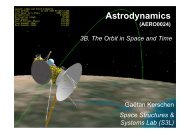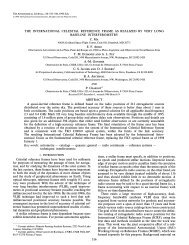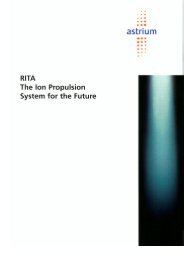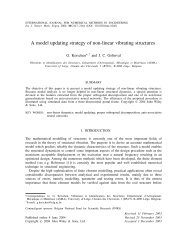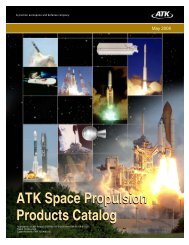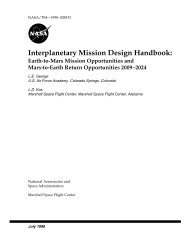CASSINI MANEUVER EXPERIENCE: FINISHING INNER CRUISE
CASSINI MANEUVER EXPERIENCE: FINISHING INNER CRUISE
CASSINI MANEUVER EXPERIENCE: FINISHING INNER CRUISE
You also want an ePaper? Increase the reach of your titles
YUMPU automatically turns print PDFs into web optimized ePapers that Google loves.
TCM-8<br />
The cancellation of TCM-8 was anticipated; that much is<br />
clear from Table I. When the scheduled time for TCM-8<br />
arrived, the required B-plane shift was only 2 km and the TCA<br />
correction needed was only 2 seconds. In fact, this translated<br />
into a 4 d s savings for TCM-9; in other words, some of the<br />
TCM-9 bias removal was already taken care of. Seeing that<br />
this difference was within the navigation delivery statistics for<br />
TCM-8, the flight team decided that the delivery could not be<br />
improved much considering the expected execution errors<br />
from TCM-8 and so the maneuver was cancelled.<br />
Venus-2<br />
The Venus-2 swingby occurred on June 24, 1999 at<br />
approximately 20:29:55 UTC. It was the only non-targeted<br />
swingby during interplanetary cruise. That isn’t to say that the<br />
swingby wasn’t necessary, but that the maneuver sequence<br />
leading up to Venus-2 aimed at points in Earth’s B-plane, not<br />
Venus’.<br />
TCM-9<br />
The first of the post-Venus, four Earth-bias-removal<br />
maneuvers and doubling as the Venus-2 swingby clean-up,<br />
TCM-9 was scheduled for 45 days before the swingby with<br />
Earth.<br />
TCM-9 was the first maneuver to include the 3 rnds<br />
deadband-tightening AV in its design, reducing the total AV<br />
error by that amount.<br />
Unfortunately, the geometry of bias to be removed was<br />
not favorable for radiometric tracking. As can be seen in<br />
Table V, the look angle for this maneuver was near 90”.<br />
Individual AV events could not be discerned and so the only<br />
estimates are for TCM-9 total AV. Furthermore, TCM-9 had a<br />
large B-R component to its bias removal, as seen in Figure 2,<br />
so that there was a large out-of-plane component to its AV,<br />
making the estimation of TCM-9 that much more difficult.<br />
8<br />
-27 -1 8 -9 0<br />
pointing error along X (mrad)<br />
Figure 8: TCM-7 Pointing Errors in Pointing Plane<br />
After TCM-9, the system was regulated, fuel-side only.<br />
This ensured that the bipropellant system would have<br />
acceptable operating conditions for the rest of the cruise<br />
trajectory.<br />
TCM-10<br />
The unfavorable geometry was a little worse for TCM-<br />
10, whose AV was mostly perpendicular to the trajectory plane<br />
making the orbit estimation more difficult, but entirely within<br />
mission requirements.[lO] In hindsight, had more resources<br />
been available pre-launch,<br />
improved.<br />
this geometry might have been<br />
TCM-10 was the first maneuver to include both the<br />
3 mds deadband-tightening AV and the 7.6 rnds pointingbias-fix<br />
AV in its design. The net effect was to reduce the<br />
magnitude error by 7.6 mm/s and to reduce the pointing error<br />
by about 3 d s . All later maneuvers incorporated these AVs<br />
into their designs.<br />
TCM-11<br />
There was some consideration given to pre-designing, or<br />
canning-in, the design for TCM-11; the idea being that the<br />
design could be made months in advance, lightening the work<br />
load during these three months between Venus-2 and Earth.<br />
The AV cost would be small. On the other hand, all the<br />
ground system procedures would be different for this one<br />
maneuver. Rather than risk the confusion, TCM-11 was not<br />
canned-in; it took advantage of the same design process used<br />
for the other maneuvers.<br />
I



